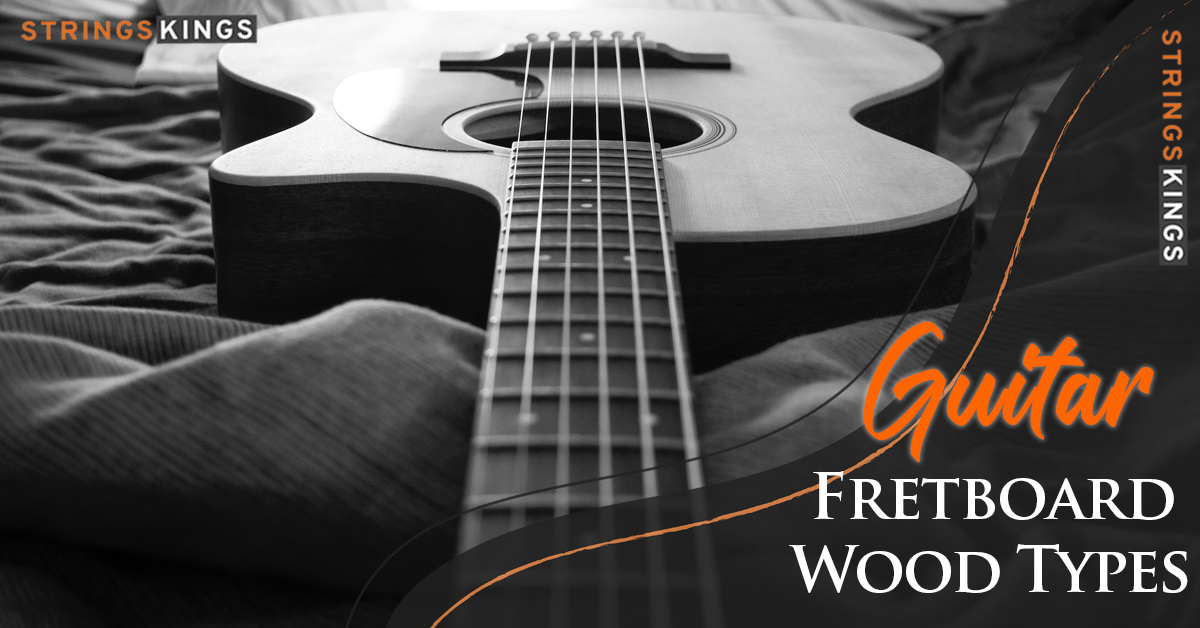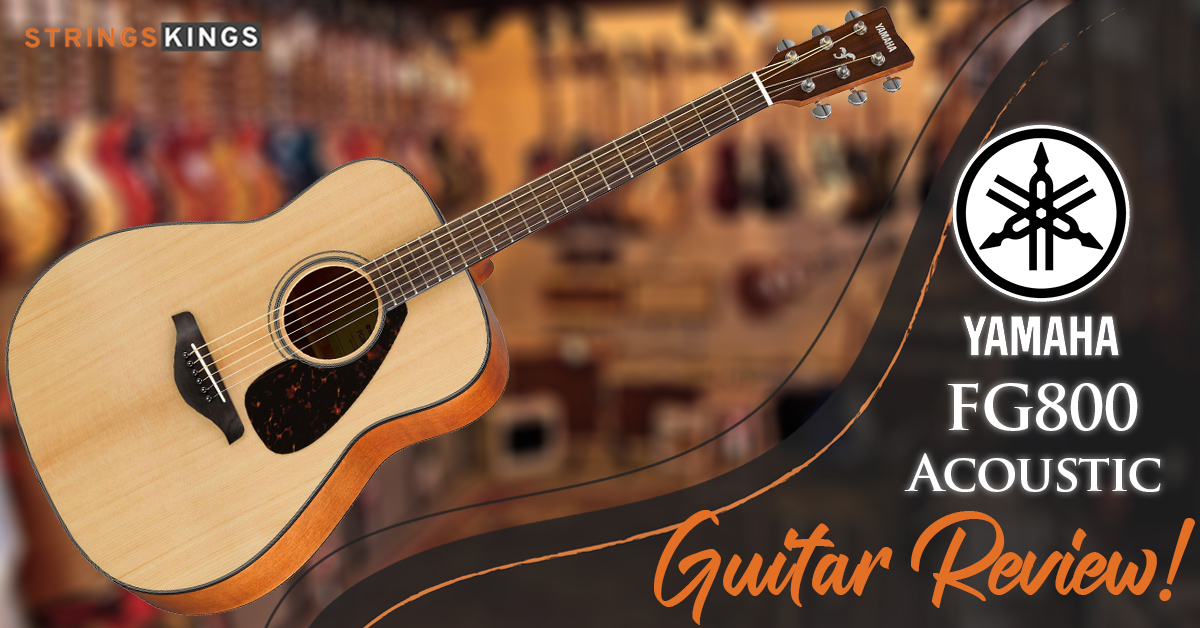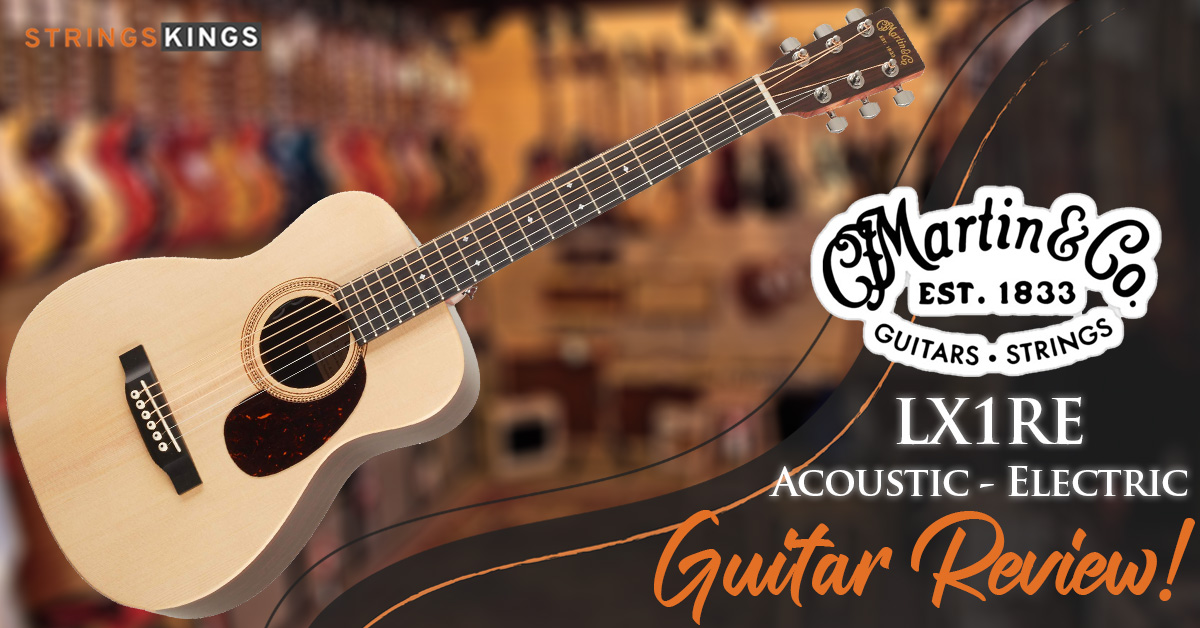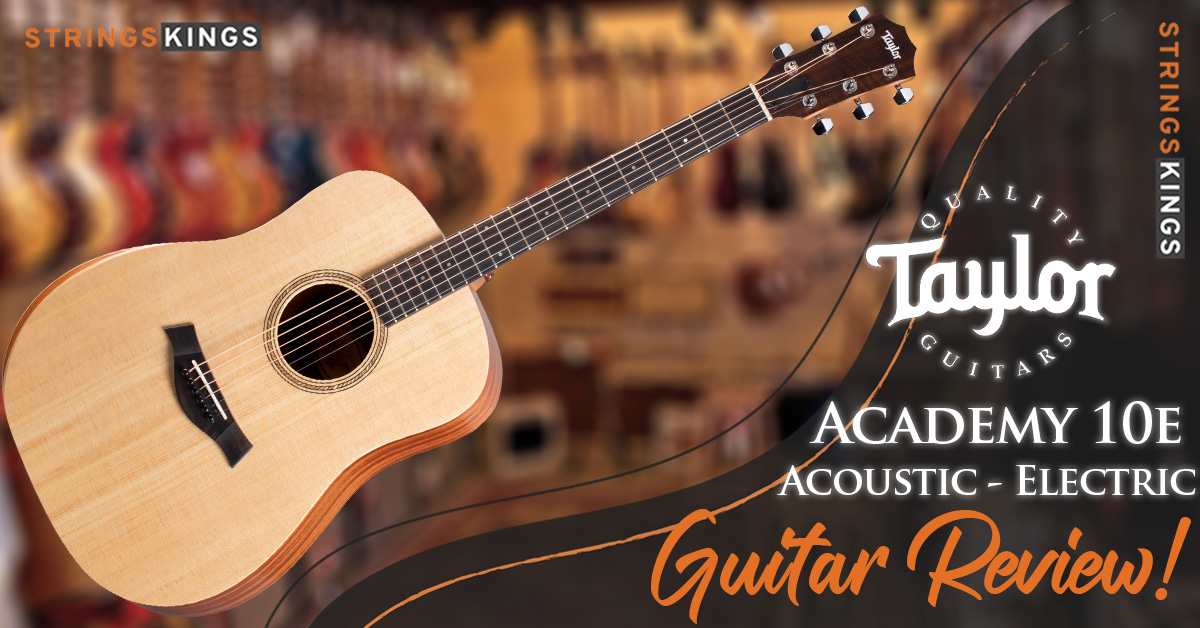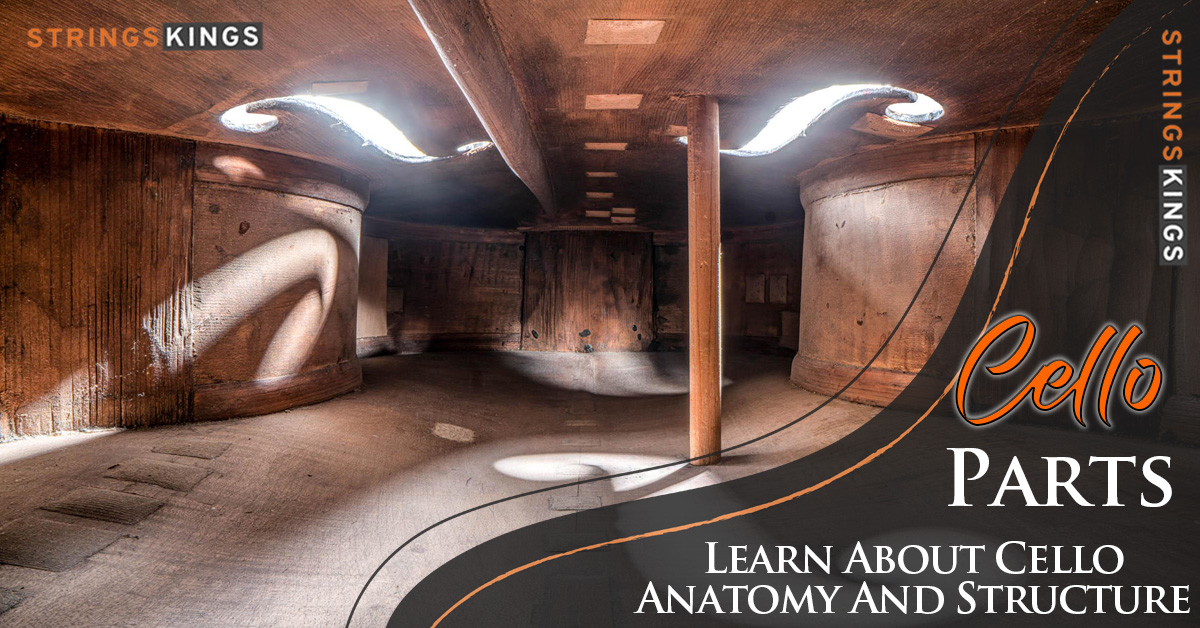Table of Contents
Learn Everything About Guitar Headstock Types, Usage, Positives, and Negatives!
Guitar headstocks (or “head”) play a crucial role in the guitar’s design. As well as being one of the most noticeable parts of a guitar, it gives it its own unique identity.
Headstocks and decals are distinctive for each type of guitar and brand. It also houses machine heads, tuning posts, string trees, and more, making the headstock essential to the guitar’s performance and sound.

What are the different types of guitar headstocks? How many types are there? Guitar headstocks come in three different types.
Among the headstock types, you will find the Straight headstock, the Tilted-back headstock, and the Scarf headstock. Manufacturers usually vary this construction and customize the design slightly for each brand, but these types of headstocks are common to all brands.
The purpose of this article is to introduce you to the different types of guitar headstocks and how to pick and use them appropriately.
The Guitar Headstock – What is it?
The guitar headstock serves primarily to tune and hold the strings after they have been tuned. There are four components in the guitar headstock: the Nut, Tuning Pegs/Machine Heads, Trust Rod, and the headstock head.
- The Nut – The string leans on this part between the fretboard and headstock.
- Tuning Pegs or Machine Heads – strings are held in place by this component, which also adjusts the tuning. Tuners or tuning pegs are located on the headstock, where we adjust the pitch of the sound the guitar produces and tweak the strings.
- Truss Rod – a truss rod is located on the headstock, above the nut, and is used to adjust guitar neck tension.
- Headstock Head – at the top of the headstock, the guitar’s brand and manufacturer name are displayed on the headstock’s head. Different types of guitars have different headstock designs. As a result, their shapes will naturally vary and their purposes will change as well. Aside from aesthetic reasons, guitar headstocks of different brands are constructed differently to differentiate them from their competitors.
How important is the guitar headstock?
Among the most crucial components that ensure your guitar functions properly are the Nut, Tuning Pegs/Machine Heads, and Trust Rod in the guitar headstock.
Recent advances in design have made it possible to house these parts on the guitar body rather than on the headstock. In spite of the fact that this design makes the guitar noticeably lighter, there is a major flaw in it. As a result, there is a lack of flexibility in tuning while playing.
Because of the fact that you can’t tune your guitar while you’re playing, they aren’t ideal for live performances. In addition, they are quite expensive. Due to these two reasons, these guitars have not yet completely replaced the headstock, making it still an essential part.
1. The Scarf Headstock
The Scarf headstock has an angled appearance. In this case, the neck and the headstock are made from a single straight piece of wood that is cut into two pieces. The headstock and neck are glued together at an angle.
In order to make a scarf joint, the wood must be cut in two places so that the wood can be assembled back together.
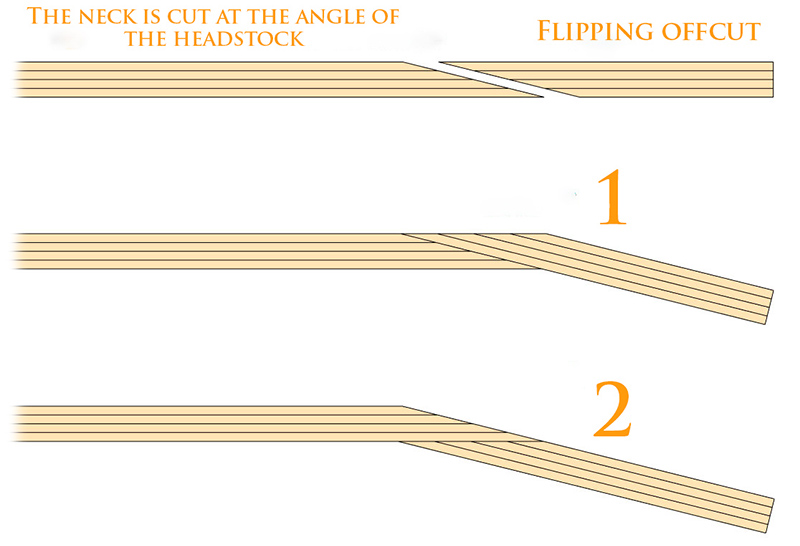
Scarf Headstock – Pros
This guitar headstock provides stability for the strings and an overall good tone. Additionally, this design approach strengthens the guitar’s construction. Having aligned grains across the neck and the headstock strengthens the whole structure.
Scarf Headstock – Cons
Just as with the straight headstock, this headstock is made of one straight piece of wood. Because of this, this method requires less material expense than tilted-back headstocks and therefore should be cheaper. Moreover, luthiers are able to ensure the quality of the wood at a low price due to the fewer materials used.
Compared to the straight headstock, this headstock is one step more complex. This requires more time and a certain level of expertise when cutting and gluing the two pieces together. Even though it is cheaper than the tilted-back headstock, it is still more expensive than the straight headstock.
2. The Tilted-back Guitar Headstock
A tilted back headstock, also known as an angled non-jointed headstock, forms a noticeable angle with the neck. Tilted-back headstocks require one whole piece of wood, just like straight headstocks. Due to the curve in the tilted back headstock, it requires more material, so it’s more expensive to produce too.
It can be found on mid to high-end guitars, such as Ibanez or Gibson, despite the latter receiving most of the attention.

Tilted-back Guitar Headstock – Pros
With the angled headstock, the flaw inherent in straight headstocks was minimized. An angled headstock will allow strings to be slotted into guitar nut grooves deeper.
Using this construction reduces the likelihood of guitar strings slipping out or detuning. In addition, many people believe that the wholeness of the material creates a vibrant and expressive tone.
Tilted-back Guitar Headstock – Cons
In spite of this, there is a notion that tilted-back headstocks lack structural integrity. A large angle exerts considerable pressure on the neck and headstock, placing them at greater risk of breaking.
There is evidence to support this myth. A famous example of this is the angled headstocks on Gibson guitars. Guitar necks are the thinnest and weakest between the neck and headstock because of the short wood grain.
Producing Tilted Back headstocks is also costly. To form the angle, more material is required. As a result, this method generates a large amount of excess material and waste. A larger amount of material to work with means longer production time. Due to these reasons, guitars with this feature are more expensive.
Creating a complex guitar headstock would require many hours of work and a high level of craftsmanship. As a result, production is exclusive to luthiers, and therefore, the average worker cannot design it.
3. The “Straight” Headstock Type
As its name implies, the Straight headstock does not have any angles in it. Guitar headstocks and necks are constructed from one piece of flat wood.
Because of its low production cost and strength, this type of headstock is easily recognized and common. The early Stratocaster by Fender popularized this type of headstock.

The Straight Headstock – Pros
The simplicity of its design accounts for its low cost. The ability to mass production can reduce the final cost of a business in an industry.
The cost of materials can be dramatically reduced by building the neck and headstock from one wooden plank. Wood of this size is readily available and can be found at a reasonable price.
Furthermore, an unsawn piece of wood demonstrates the strength of the structural integrity between the neck and headstock, which enhances the resistance of the guitar as a whole. A key to this instrument lies in the intact wood grains, which connect the neck and headstock.
The Straight Headstock – Cons
In spite of this, many people believe the angle doesn’t push the strings hard enough down the nut, making them less solid and harder to hold tuning. By introducing a new, more slippery material to the nut, this flaw has been alleviated and friction has been reduced.
Guitars with straight headstocks are usually mass-produced by Squier, Jackson, or Yamaha.
What Are The Parts Of A Guitar Headstock?
Nut
The guitar nut prevents strings from slipping out and detuning by holding them between the machine heads and the fretboard. Hard and dense materials are usually used to make guitar nuts.
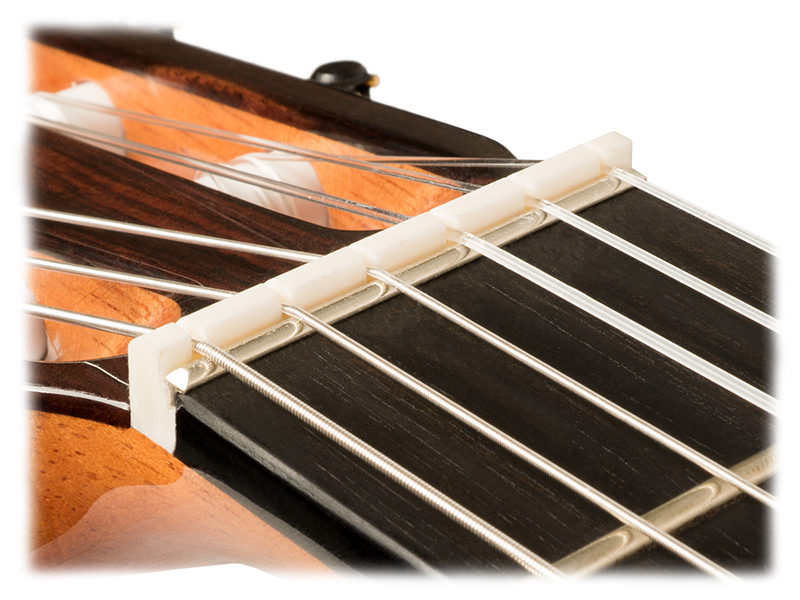
Due to the fact that dense materials convey sound more easily, soft and vibrant sounds are produced. Ebony, ivory, and bone are the most commonly used materials for nuts. However, obtaining large quantities of these materials is considered a felony because they are rare and very expensive.
Manufacturers have responded by developing new materials with similar properties, but without endangering animals. The Tusq material has been introduced by brands such as Graphtech, guaranteeing a rich and crystal-clear sound. Plastic is the most common material for budget guitars.
The nut has grooves engraved on it that serve as slots for the strings. When played on open strings, the nut directly affects the guitar’s sound. Moreover, the nut should be smooth and free of rough edges, since these can damage the strings over time. By applying graphite to the grooves, friction between the strings and the nut can be reduced.
Tuning Pegs/Machine Heads
Tuning the pitch of the guitar is done with machine heads on either side of the headstock. Guitar machine heads use gears instead of friction to hold the strings, as do many traditional stringed musical instruments.
The gears prevent the capstan from moving independently of the knob. Tuning is also improved by lubricating the gears.
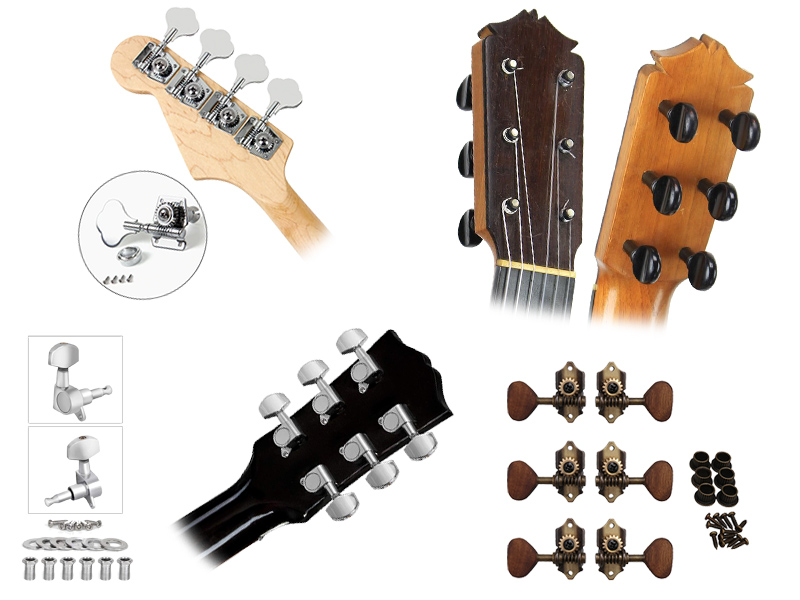
A classical guitar differs from a modern or folk guitar. On the classical guitar, the machine heads are located on both sides of the headstock. This case typically displays exposed gears, which are slotted into ornate braces above plastic tuning knobs.
Unlike earlier steel-stringed guitars, modern steel-stringed guitars have their gears enclosed in a metal housing. As a result, the gears are more protected. Permanent lubrication is applied to the gears inside. Moreover, machine heads are positioned on the back of headstocks, as opposed to their classical counterparts.
Truss Rod
There is a sturdy metal bar running inside the neck of the guitar called the truss rod. You can adjust the truss rod at either end of the guitar neck, above the nut, or at the other end, inside the body.
As well as allowing players to adjust the guitar action, the truss rod has the passive function of adding strength to the neck. This will prevent it from breaking under physical and environmental stresses. Truss rods are generally classified as single-action or dual-action.
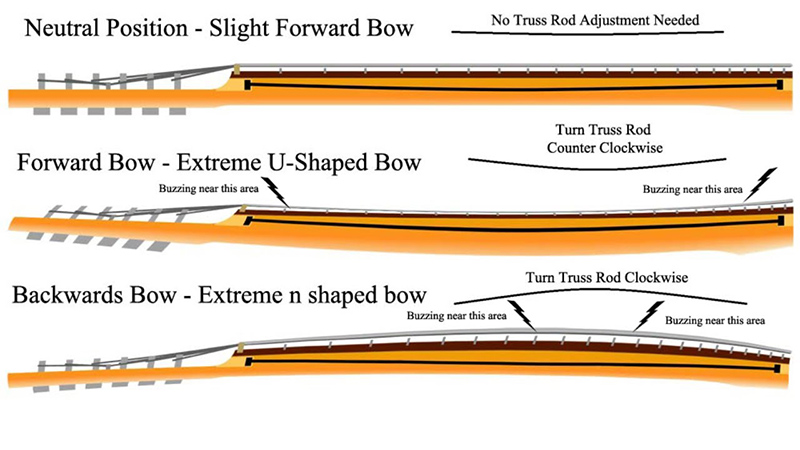
Players can bend their necks slightly backward when using single-action truss rods. In general, this type of truss rod is used to prevent the neck from bending over time as a result of string tension.
This truss rod has the primary advantage of being lightweight and easy to use. Depending on the humidity, the neck can bend in either direction depending on the changes in the atmosphere.
Dual-action truss rods, on the other hand, and the neck either in response to string tension or against it. A dual-action truss rod is heavier than a single-action truss rod, but also more rigid, and more susceptible to the weather. The player can also experiment with the truss rod since many people prefer to lower the action for easy and rapid execution.
Headstock Head
Usually, on the head of the headstock, or the top of the headstock, there is a place that is used to display the logo of the manufacturer.
Volute
Volutes are usually found on scarf headstock joints and they are ridges that provide support and tuning stability to guitars that have angled headstocks, and they are located in the weaker area of a scarf headstock joint.
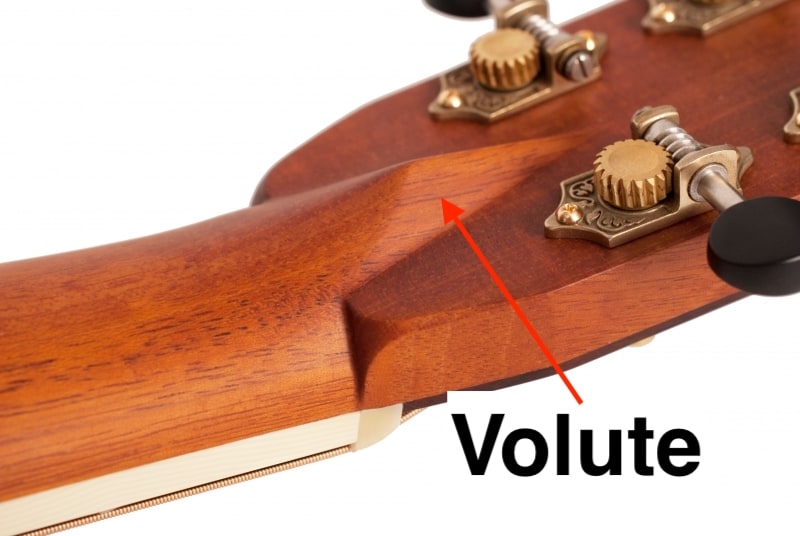
It is important for me to provide clarity, so we are going to elaborate a little on what a volute is in a bit more detail. A volute, or what is also known as a “carved heel,” is a triangular reinforced beam placed between the headstock and the fretboard, located in the middle of the guitar.
As a result, these considerations are only applicable to tilted headstocks, which have been designed to have a weak point at the point where the neck and fretboard join (scarf joint) in tilted headstocks.
In order for a beam to be reinforced it must require thickening of the wood, which is usually triangular, due to the fact that triangles are known to be the strongest shapes.
Tonewood
Tonewoods are used for headstocks of many different types. The tone can be bright or mellow depending on the grain and density of each of these.
Headstocks are always made from the same wood type as the guitar neck, which is most commonly (but not limited to) rosewood, mahogany, or maple.
Get to know more about Guitar headstocks from this interesting video:
Last Words
The headstock, like the instrument, has undergone numerous modifications over the years. Guitar headstocks have evolved from sharing their design with the violin or lute to having their own unique shape.
In general, each manufacturer and brand has its own headstock design, but all of them are either straight, tilted, or scarfed.
Hopefully, our article helped you understand the guitar headstocks better since they are very important parts of your instrument.
Happy Strumming!


